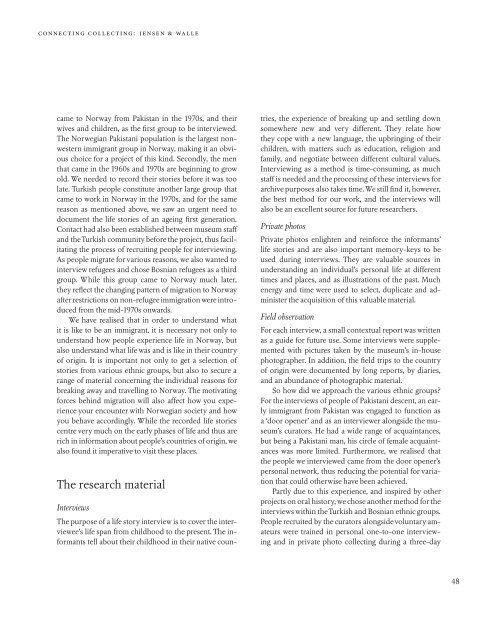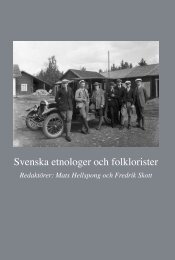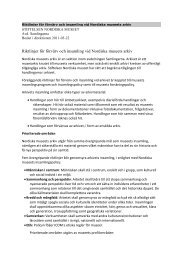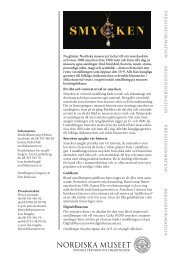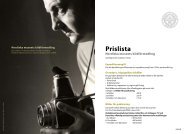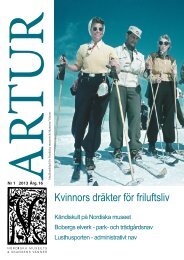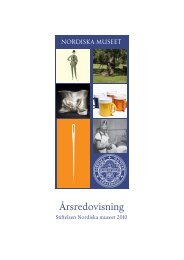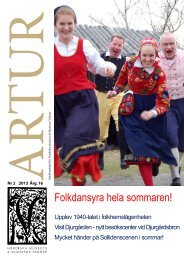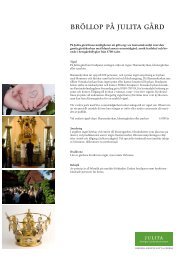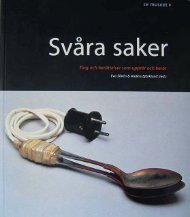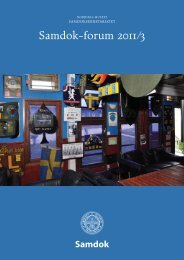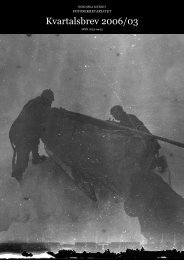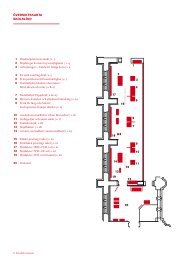Samdok - Nordiska museet
Samdok - Nordiska museet
Samdok - Nordiska museet
You also want an ePaper? Increase the reach of your titles
YUMPU automatically turns print PDFs into web optimized ePapers that Google loves.
connecting collecting: jensen & walle<br />
came to Norway from Pakistan in the 1970s, and their<br />
wives and children, as the first group to be interviewed.<br />
The Norwegian Pakistani population is the largest nonwestern<br />
immigrant group in Norway, making it an obvious<br />
choice for a project of this kind. Secondly, the men<br />
that came in the 1960s and 1970s are beginning to grow<br />
old. We needed to record their stories before it was too<br />
late. Turkish people constitute another large group that<br />
came to work in Norway in the 1970s, and for the same<br />
reason as mentioned above, we saw an urgent need to<br />
document the life stories of an ageing first generation.<br />
Contact had also been established between museum staff<br />
and the Turkish community before the project, thus facilitating<br />
the process of recruiting people for interviewing.<br />
As people migrate for various reasons, we also wanted to<br />
interview refugees and chose Bosnian refugees as a third<br />
group. While this group came to Norway much later,<br />
they reflect the changing pattern of migration to Norway<br />
after restrictions on non-refugee immigration were introduced<br />
from the mid-1970s onwards.<br />
We have realised that in order to understand what<br />
it is like to be an immigrant, it is necessary not only to<br />
understand how people experience life in Norway, but<br />
also understand what life was and is like in their country<br />
of origin. It is important not only to get a selection of<br />
stories from various ethnic groups, but also to secure a<br />
range of material concerning the individual reasons for<br />
breaking away and travelling to Norway. The motivating<br />
forces behind migration will also affect how you experience<br />
your encounter with Norwegian society and how<br />
you behave accordingly. While the recorded life stories<br />
centre very much on the early phases of life and thus are<br />
rich in information about people’s countries of origin, we<br />
also found it imperative to visit these places.<br />
The research material<br />
Interviews<br />
The purpose of a life story interview is to cover the interviewee’s<br />
life span from childhood to the present. The informants<br />
tell about their childhood in their native coun-<br />
tries, the experience of breaking up and settling down<br />
somewhere new and very different. They relate how<br />
they cope with a new language, the upbringing of their<br />
children, with matters such as education, religion and<br />
family, and negotiate between different cultural values.<br />
Interviewing as a method is time-consuming, as much<br />
staff is needed and the processing of these interviews for<br />
archive purposes also takes time. We still find it, however,<br />
the best method for our work, and the interviews will<br />
also be an excellent source for future researchers.<br />
Private photos<br />
Private photos enlighten and reinforce the informants’<br />
life stories and are also important memory-keys to be<br />
used during interviews. They are valuable sources in<br />
understanding an individual’s personal life at different<br />
times and places, and as illustrations of the past. Much<br />
energy and time were used to select, duplicate and administer<br />
the acquisition of this valuable material.<br />
Field observation<br />
For each interview, a small contextual report was written<br />
as a guide for future use. Some interviews were supplemented<br />
with pictures taken by the museum’s in-house<br />
photographer. In addition, the field trips to the country<br />
of origin were documented by long reports, by diaries,<br />
and an abundance of photographic material.<br />
So how did we approach the various ethnic groups?<br />
For the interviews of people of Pakistani descent, an early<br />
immigrant from Pakistan was engaged to function as<br />
a ‘door opener’ and as an interviewer alongside the museum’s<br />
curators. He had a wide range of acquaintances,<br />
but being a Pakistani man, his circle of female acquaintances<br />
was more limited. Furthermore, we realised that<br />
the people we interviewed came from the door opener’s<br />
personal network, thus reducing the potential for variation<br />
that could otherwise have been achieved.<br />
Partly due to this experience, and inspired by other<br />
projects on oral history, we chose another method for the<br />
interviews within the Turkish and Bosnian ethnic groups.<br />
People recruited by the curators alongside voluntary amateurs<br />
were trained in personal one-to-one interviewing<br />
and in private photo collecting during a three-day<br />
48


